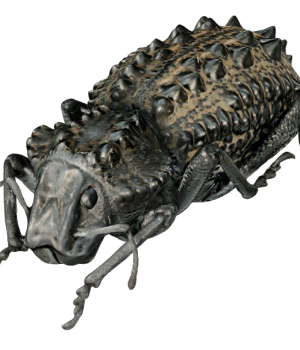This SMART 100 profile and the information it contains is a duplication of content submitted by the applicant during the entry process. As a function of entry, applicants were required to declare that all details are factually correct, do not infringe on another’s intellectual property and are not unlawful, threatening, defamatory, invasive of privacy, obscene, or otherwise objectionable. Some profiles have been edited for reasons of space and clarity.
Learn more about the SMART 100 >>
1. THE BEGINNING
This innovation initially came to life when…
CSIRO researchers realised there was no existing system for capturing 3D models of insects, in natural colour.
Motivated by CSIRO’s mission to deliver benefit from science, they set out to create a system that could digitise some of the most precious specimens in global biological collections and also help, for example, quarantine officers working to protect our biosecurity.
While initially developed with biological applications in mind, the system can be deployed wherever tiny objects are found including medical applications, forensics, and manufacturing.
2. WHAT & HOW
The purpose of this innovation is to…
…capture natural colour, high resolution 3D models of tiny objects. The end products are compact 3D models that can be archived or shared over the web.
It does this by…
…automatically capturing between 150 and 4500 photographs of tiny object and feeding them into a 3D reconstruction engine.
This compresses 10-25GB of photos into a roughly 10MB 3D model that is comparable in quality to the original photos. The 3D model can be shared and displayed over the web without the need for any special plugins.
3. PURPOSE & BENEFITS
This innovation improves on what came before because…
…previous 3D capture systems such as CT scanners are much more expensive and do not capture the natural colour of the tiny object.
Its various benefits to the customer/end-user include…
…minimal sample preparation, no pre-scan calibration, no x-ray source, relatively affordable, and it is non-destructive. The output 3D model is also optimised, sharable and ISO standard compliant.
4. COMPETITIVE LANDSCAPE
In the past, this problem was solved by…
…using either expensive medical scanners without colour or just 2D images without any 3D information.
Its predecessors/competitors include…
…a wide range of 3D scanning/reconstruction technologies, however InsectScan3D is the first system to produce colour 3D models of such small biological specimens.
5. TARGET MARKET
It is made for…
…anyone who wants a 3D model of something tiny. InsectScan3D was initially developed with researchers, biological collections and educators in mind and therefore the hardware costs have been kept as low as possible. However, it also has broader applicability in a wide range of industries.
It is available for sale through…
…partnerships. Please contact CSIRO if you are interested in using InsectScan3D.
Our marketing strategy is to…
…educate potential users about the system. Besides the video we have produced, we have also published a research paper.
FINE PRINT: This SMART 100 profile and the information it contains is a duplication of content submitted by the applicant during the entry process. As a function of entry, applicants were required to declare that all details are factually correct, do not infringe on another’s intellectual property and are not unlawful, threatening, defamatory, invasive of privacy, obscene, or otherwise objectionable. Some profiles have been edited for reasons of space and clarity.





![Roam [SMART 100, 2015]](https://anthillonline.com/wp-content/uploads/2015/04/roam_thumb-238x178.jpg)
![How to give good headlines, and create emails that get opened [CHEAT SHEET]](https://anthillonline.com/wp-content/uploads/2013/11/7-steps-cheatsheet-3d-cover-nuova--300x194.png)
![How to pitch sales and marketing ideas to your boss with James Tuckerman [FREE REPORT]](https://anthillonline.com/wp-content/uploads/2015/07/Render-3-100x75.png)
![The Alchemy of Negotiation with Matt Lohmeyer [FREE REPORT]](https://anthillonline.com/wp-content/uploads/2015/07/Capture-100x75.jpg)
![The Gaddie Pitch in three simple sentences with Antony Gaddie and James Tuckerman [CHEAT SHEET]](https://anthillonline.com/wp-content/uploads/2015/08/GADDIE-PITCH-updated-3D-cover--100x75.png)
![Generating Web Traffic with Mark Middo and James Tuckerman [FREE REPORT]](https://anthillonline.com/wp-content/uploads/2015/08/Capture3-100x75.jpg)
![This one simple idea from a billion dollar inventor could catapult your startup [VIDEO]](https://anthillonline.com/wp-content/uploads/2016/08/onesimpleidea-290x300.jpg)
![Why doesn’t MTV play music videos anymore? [VIDEO]](https://anthillonline.com/wp-content/uploads/2012/11/MTVProgramming.jpg)

![Would you share your life with a stranger for 20 days? It’s an intriguing idea [VIDEO]](https://anthillonline.com/wp-content/uploads/2014/05/20DayStranger-300x350.jpg)
![Goal setting the Google way: success tips for every startup [VIDEO]](https://anthillonline.com/wp-content/uploads/2014/01/GoogleVentures-300x350.jpg)
![Five essential ingredients for a humming homepage with James Tuckerman [FREE REPORT]](https://anthillonline.com/wp-content/uploads/2015/07/homepage-checklist-1680-01-copy-300x194.png)
![Five ways to manage your time by managing yourself, with Helen Ebdon [CHEAT SHEET]](https://anthillonline.com/wp-content/uploads/2015/07/ebdon-3d-cover-01--100x75.png)
![5 Ways to get more out of your coffee shop meetings with Antony Gaddie [CHEAT SHEET]](https://anthillonline.com/wp-content/uploads/2015/07/gaddie-3d-cover-01--100x75.png)
![How Master the Art of Sales Even if it Makes You Feel All Weird and Icky Inside with Phil Anderson [CHEAT SHEET]](https://anthillonline.com/wp-content/uploads/2015/08/PHIL-ANDERSON-COVER-100x75.png)
![New Zealand’s Xero eyes US IPO, further disruption as subscribers increase [INFOGRAPHIC]](https://anthillonline.com/wp-content/uploads/2014/07/sruuuuujana-212x194.png)
![Ever wonder if your ‘content marketing’ is really just crap? You gotta see this! [INFOGRAPHIC]](https://anthillonline.com/wp-content/uploads/2014/08/content-100x75.jpg)
![7 Business Lessons From Game of Thrones [INFOGRAPHIC]](https://anthillonline.com/wp-content/uploads/2014/10/infographic-games-of-thrones-041-100x75.jpg)
![How to build your own Media Empire… In seven steps with Nathan Chan [INFOGRAPHIC]](https://anthillonline.com/wp-content/uploads/2014/10/Nathan-Chan-Infographic-e1413419529176-100x75.jpg)
![5 Business Lessons From Tinder [INFOGRAPHIC]](https://anthillonline.com/wp-content/uploads/2014/10/Tinder-Elegant-Infographic-100x75.jpg)



